INSTITUT SUPERIEUR D'ANTHROPOLOGIE
INSTITUT OF ANTHROPOLOGY
COURS ONLINE – COURS A DISTANCE
INSCRIPTIONS OUVERTES
REGISTER NOW
ANGLETERRE – 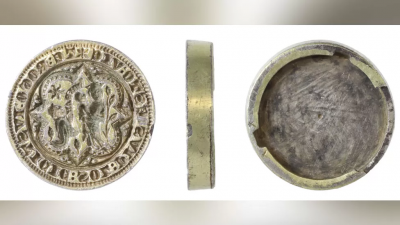 Horsham St Faith - A medieval seal die, described by experts as ‘completely unique’, has been found by a metal detector at a field near Horsham St Faith, north of Norwich in south-east England. The massive silver and gilt seal dates from the late 13th or early 14th century. Most likely, the Medieval seal matrix belonged to a monk. A medieval seal matrix discovered by a metal detectorist is “a window into someone’s spiritual world just before the Black Death”, an expert has said. On the seal matrix there is an inscription that reads: “I beseech thee, holy sun of righteousness, be the way.”According to historian Helen Geake, this inscription has not been found on any other object. The circular die, 24.6 mm in diameter, bears the central motif of the crowned Virgin Mary with the baby Jesus in her arms. To her right, a monk prays on his knees. The scroll of his joined hands shows the inscription AVE MA (Hail Mary). The entire scene is set in a four-leaf frame. The inscription in medieval Latin ‘TE: ROGO: IVSTICIE: SOL: PIVS: ESTO: VIE’ is placed in a dotted circular border around the edge of the seal. Iconography of the Virgin Mary with a kneeling monk is relatively common on seals, private and official church documents, but there is no directly comparable example of this depiction on a circular seal. The “Sun of Righteousness” appears at the end of a number of prophecies in the Old Testament and became a relatively common way of referring to Jesus Christ in the Middle Ages. This matrix has another very unusual feature: a recessed sleeve with a scalloped edge on the reverse, suggesting that it had a removable handle which could be retracted and secured by turning. Seals with sleeves are known from archaeology, but their handles were permanently fitted without the possibility of replacement. This is a completely unique feature with no equivalent. Dr. Geake said another “unusual” aspect of the find is that it appears to be designed for “a detachable handle, with the matrix rotating either to lock it in position, or to remove it, as if interchangeable die could be used with the same handle”. The die is the part of the matrix which stamps wax.
Horsham St Faith - A medieval seal die, described by experts as ‘completely unique’, has been found by a metal detector at a field near Horsham St Faith, north of Norwich in south-east England. The massive silver and gilt seal dates from the late 13th or early 14th century. Most likely, the Medieval seal matrix belonged to a monk. A medieval seal matrix discovered by a metal detectorist is “a window into someone’s spiritual world just before the Black Death”, an expert has said. On the seal matrix there is an inscription that reads: “I beseech thee, holy sun of righteousness, be the way.”According to historian Helen Geake, this inscription has not been found on any other object. The circular die, 24.6 mm in diameter, bears the central motif of the crowned Virgin Mary with the baby Jesus in her arms. To her right, a monk prays on his knees. The scroll of his joined hands shows the inscription AVE MA (Hail Mary). The entire scene is set in a four-leaf frame. The inscription in medieval Latin ‘TE: ROGO: IVSTICIE: SOL: PIVS: ESTO: VIE’ is placed in a dotted circular border around the edge of the seal. Iconography of the Virgin Mary with a kneeling monk is relatively common on seals, private and official church documents, but there is no directly comparable example of this depiction on a circular seal. The “Sun of Righteousness” appears at the end of a number of prophecies in the Old Testament and became a relatively common way of referring to Jesus Christ in the Middle Ages. This matrix has another very unusual feature: a recessed sleeve with a scalloped edge on the reverse, suggesting that it had a removable handle which could be retracted and secured by turning. Seals with sleeves are known from archaeology, but their handles were permanently fitted without the possibility of replacement. This is a completely unique feature with no equivalent. Dr. Geake said another “unusual” aspect of the find is that it appears to be designed for “a detachable handle, with the matrix rotating either to lock it in position, or to remove it, as if interchangeable die could be used with the same handle”. The die is the part of the matrix which stamps wax.
A Detectorist has Discovered a Completely Unique Medieval Seal Matrix in the UK - Arkeonews
FINLANDE – 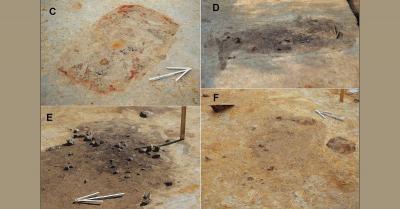 Tainiaro - Archaeologists have found a mysterious prehistoric site believed to be a 6,500-year-old Stone Age cemetery just 50 miles (80 kilometers) south of the Arctic Circle. The prehistoric site is known as Tainiaro, located about 50 miles south of the Arctic Circle in the Finnish region of Lapland. Although the hypothesis that the Tainiaro site is a Stone Age cemetery remains unproven, if confirmed, it could drastically alter ideas about the history of Northern Europe. Furthermore, the proof would make Tainiaro the northernmost Stone Age graveyard in the world. Back in 1959, local workers came across stone tools in Simo, which is situated near the Baltic Sea’s northern edge, just 80 kilometers to the south of the Arctic Circle. The site, named Tainiaro, underwent partial excavations in the 80s. This led to the revelation of thousands of artifacts, including pottery, stone tools, and animal bones. The archaeologists were also able to notice 127 possible pits of different sizes that could have been sediment-filled. Some had burning evidence, while others had red ochre traces. Red ochre is a natural iron pigment that is crucial to several burials of the Stone Age. However, without skeletal evidence, which quickly decayed in the acidic soil of this region, the Taniaro’s identification as a cemetery was never confirmed. The team of archaeologists working on the site has published its findings and theories in the Cambridge University Press archaeological journal Antiquity in the paper entitled “A large fifth-millennium BC cemetery in the subarctic north of the Baltic Sea.” Archaeologists were initially unsure whether the pits were graves, hearths, or a combination of the two. To determine the nature, the team examined the contents and sizes of the pits and compared them to hundreds of Stone Age graves in 14 cemeteries. The archaeologists were then able to determine that at least 44 of these could have housed human burials. Furthermore, the pits’ rounded-edge rectangular shape, red ochre traces, and occasional artifacts suggest that they were graves. The authors note in the study that Tainiaro should be considered a cemetery despite no skeletal material surviving in the area was found. Their research paper mentions, “Despite the absence of skeletal evidence, dozens of fifth-millennium BC pits have been tentatively interpreted as burials… Many of the pits are consistent in form with those used for inhumation at contemporaneous sites suggesting that Tainiaro is one of the largest Stone Age cemeteries in northern Europe and raising questions about the cultural and subsistence practices of prehistoric societies in the subarctic.”
Tainiaro - Archaeologists have found a mysterious prehistoric site believed to be a 6,500-year-old Stone Age cemetery just 50 miles (80 kilometers) south of the Arctic Circle. The prehistoric site is known as Tainiaro, located about 50 miles south of the Arctic Circle in the Finnish region of Lapland. Although the hypothesis that the Tainiaro site is a Stone Age cemetery remains unproven, if confirmed, it could drastically alter ideas about the history of Northern Europe. Furthermore, the proof would make Tainiaro the northernmost Stone Age graveyard in the world. Back in 1959, local workers came across stone tools in Simo, which is situated near the Baltic Sea’s northern edge, just 80 kilometers to the south of the Arctic Circle. The site, named Tainiaro, underwent partial excavations in the 80s. This led to the revelation of thousands of artifacts, including pottery, stone tools, and animal bones. The archaeologists were also able to notice 127 possible pits of different sizes that could have been sediment-filled. Some had burning evidence, while others had red ochre traces. Red ochre is a natural iron pigment that is crucial to several burials of the Stone Age. However, without skeletal evidence, which quickly decayed in the acidic soil of this region, the Taniaro’s identification as a cemetery was never confirmed. The team of archaeologists working on the site has published its findings and theories in the Cambridge University Press archaeological journal Antiquity in the paper entitled “A large fifth-millennium BC cemetery in the subarctic north of the Baltic Sea.” Archaeologists were initially unsure whether the pits were graves, hearths, or a combination of the two. To determine the nature, the team examined the contents and sizes of the pits and compared them to hundreds of Stone Age graves in 14 cemeteries. The archaeologists were then able to determine that at least 44 of these could have housed human burials. Furthermore, the pits’ rounded-edge rectangular shape, red ochre traces, and occasional artifacts suggest that they were graves. The authors note in the study that Tainiaro should be considered a cemetery despite no skeletal material surviving in the area was found. Their research paper mentions, “Despite the absence of skeletal evidence, dozens of fifth-millennium BC pits have been tentatively interpreted as burials… Many of the pits are consistent in form with those used for inhumation at contemporaneous sites suggesting that Tainiaro is one of the largest Stone Age cemeteries in northern Europe and raising questions about the cultural and subsistence practices of prehistoric societies in the subarctic.”
Archaeologists have found a mysterious prehistoric site, believed to be a 6,500-year-old Stone Age cemetery, near the Arctic Circle - Arkeonews
TURQUIE – 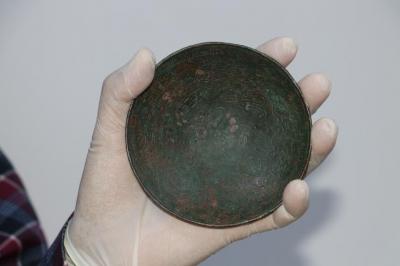 Hasankeyf - During the ongoing excavations in the Hasankeyf mound in Batman, one of the oldest settlements in the world, an 800-year-old healing bowl and two zihgir (archery rings) made of agate and bone used by archers were found. Associate Professor Zekai Erdal stated that there are only 22 healing bowls in the world, reaching 23 with Hasankeyf, and said that they unearthed a healing bowl made of bronze material used in folk medicine in the medieval Islamic world. Assoc. Dr. Erdal said, “The healing bowl, adorned with talismans, seals, and verses, actually has a connection with Hasankeyf in one aspect. According to local belief, it is accepted that the people of Hasankeyf or the people who go to the castle are not bitten by scorpions or snakes,” Stating that it is believed that the bowl, on which double-headed dragon, dog, snake, and scorpion motifs are engraved, protects in two ways, Erdal said, “It is believed that the person who drinks water from the healing bowl is protected against dog bites, snake and scorpion bites. Healing bowl is a material used to heal people who are exposed to dog bites, snake and scorpion bites.” The purpose of the healing bowl was believed to protect individuals from natural dangers such as dog bites, snake, and scorpion stings. It was used in folk medicine with the belief that drinking water from it could provide remedies for those who encountered such animal-related harms. Erdal stated that they found two zihgir, similar examples of which they had not encountered in previous excavations, along with the healing bowl, and said:“One of the Zihgir (archery rings) was discovered during an excavation at a shrine. This suggests that the individual buried there was of significance, although their identity couldn’t be determined. The Zihgirs were made of agate and bone. In the medieval, the zihgir was one of the most important elements used in the Islamic world and Turkish Islamic arts, particularly in archery. It was a ring-shaped tool worn on the finger during archery to prevent the bowstring from harming the finger.”
Hasankeyf - During the ongoing excavations in the Hasankeyf mound in Batman, one of the oldest settlements in the world, an 800-year-old healing bowl and two zihgir (archery rings) made of agate and bone used by archers were found. Associate Professor Zekai Erdal stated that there are only 22 healing bowls in the world, reaching 23 with Hasankeyf, and said that they unearthed a healing bowl made of bronze material used in folk medicine in the medieval Islamic world. Assoc. Dr. Erdal said, “The healing bowl, adorned with talismans, seals, and verses, actually has a connection with Hasankeyf in one aspect. According to local belief, it is accepted that the people of Hasankeyf or the people who go to the castle are not bitten by scorpions or snakes,” Stating that it is believed that the bowl, on which double-headed dragon, dog, snake, and scorpion motifs are engraved, protects in two ways, Erdal said, “It is believed that the person who drinks water from the healing bowl is protected against dog bites, snake and scorpion bites. Healing bowl is a material used to heal people who are exposed to dog bites, snake and scorpion bites.” The purpose of the healing bowl was believed to protect individuals from natural dangers such as dog bites, snake, and scorpion stings. It was used in folk medicine with the belief that drinking water from it could provide remedies for those who encountered such animal-related harms. Erdal stated that they found two zihgir, similar examples of which they had not encountered in previous excavations, along with the healing bowl, and said:“One of the Zihgir (archery rings) was discovered during an excavation at a shrine. This suggests that the individual buried there was of significance, although their identity couldn’t be determined. The Zihgirs were made of agate and bone. In the medieval, the zihgir was one of the most important elements used in the Islamic world and Turkish Islamic arts, particularly in archery. It was a ring-shaped tool worn on the finger during archery to prevent the bowstring from harming the finger.”
A rare bronze talismanic healing bowl was discovered in Hasankeyf excavations - Arkeonews
ANGLETERRE – 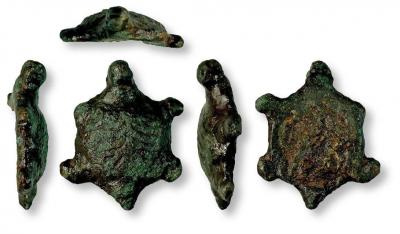 Wickham Skeith - In July last year, a small Roman copper alloy tortoise or turtle figurine was discovered by metal detectors near the village of Wickham Skeith in Suffolk, England. The tortoise figurine has a flat base with no evidence of having once had a fixing, suggesting that it was a free-standing figurine, and possibly part of a larger set of figures. There is no exact date, but experts date it to the early 2nd century AD, as a similar example was unearthed in settlement layers dating to around 100-400 AD during excavations in the Roman city of Colchester. At just over one inch long and just under one inch wide, the figurine’s body is shaped like a typical turtle/tortoise shell, sub-circular in plan and D-shaped in section. While the top of the shell is very worn, it appears to have once been decorated with two sets of crescent-shaped grooves, positioned on either side of the midpoint. The figurine has a crudely shaped head protruding from the apex of the shell, and four feet projecting from the sides. The left forelimb seems to have been broken away some time ago, leaving only a short stump. There is also a small tail on the lower edge. The underside of the shell is flat and does not appear to have been decorated. Tortoises or turtles were most often associated with the god Mercury in the Roman world and Mercury is often found accompanied by turtles/tortoises in iconography. Mercury was the god of commerce, communication and travellers. A possible reason for the association with Mercury was that tortoise shells were used for making lyres, stringed musical instruments used in antiquity, the invention of which is attributed to Mercury in mythology. It may have been associated with Sabazios, too, a god of the Phrygians and Thracians.
Wickham Skeith - In July last year, a small Roman copper alloy tortoise or turtle figurine was discovered by metal detectors near the village of Wickham Skeith in Suffolk, England. The tortoise figurine has a flat base with no evidence of having once had a fixing, suggesting that it was a free-standing figurine, and possibly part of a larger set of figures. There is no exact date, but experts date it to the early 2nd century AD, as a similar example was unearthed in settlement layers dating to around 100-400 AD during excavations in the Roman city of Colchester. At just over one inch long and just under one inch wide, the figurine’s body is shaped like a typical turtle/tortoise shell, sub-circular in plan and D-shaped in section. While the top of the shell is very worn, it appears to have once been decorated with two sets of crescent-shaped grooves, positioned on either side of the midpoint. The figurine has a crudely shaped head protruding from the apex of the shell, and four feet projecting from the sides. The left forelimb seems to have been broken away some time ago, leaving only a short stump. There is also a small tail on the lower edge. The underside of the shell is flat and does not appear to have been decorated. Tortoises or turtles were most often associated with the god Mercury in the Roman world and Mercury is often found accompanied by turtles/tortoises in iconography. Mercury was the god of commerce, communication and travellers. A possible reason for the association with Mercury was that tortoise shells were used for making lyres, stringed musical instruments used in antiquity, the invention of which is attributed to Mercury in mythology. It may have been associated with Sabazios, too, a god of the Phrygians and Thracians.
A Roman copper-alloy tiny tortoise figurine found in Suffolk - Arkeonews
TURQUIE – 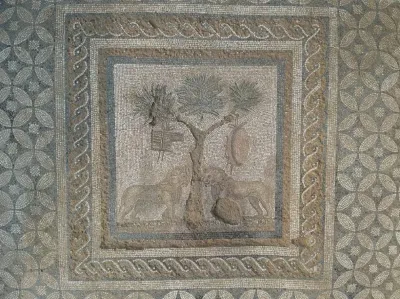 Prusias ad Hypium - Archaeologists have uncovered a mosaic depicting lions during excavations at ancient Prusias ad Hypium, located in modern-day Konuralp. A recent archaeological study has focused on the theatre, known locally as the “The Forty Stairs”. The theatre was built during the Hellenistic period (300–30 BC) and was expanded in the Roman period. The study has uncovered the remains of a mosaic depicting a pair of lions, which was found in a room of the portico in the middle of the theatre axis. The room has a rectangular shape and is adorned with a mosaic covering the entire floor with a geometric floral pattern. At the centre is a mosaic frame depicting the pair of lions either side of a pine tree. Hanging from the tree is a tympanum (a drum or tambourine), and on the left branch is a pan flute. According to the researchers, the room was dedicated to the cult of Dionysus. During Dionysian processions, it was common to observe Silenus and maenads participating by playing musical instruments such as the tympanum and pan flute.
Prusias ad Hypium - Archaeologists have uncovered a mosaic depicting lions during excavations at ancient Prusias ad Hypium, located in modern-day Konuralp. A recent archaeological study has focused on the theatre, known locally as the “The Forty Stairs”. The theatre was built during the Hellenistic period (300–30 BC) and was expanded in the Roman period. The study has uncovered the remains of a mosaic depicting a pair of lions, which was found in a room of the portico in the middle of the theatre axis. The room has a rectangular shape and is adorned with a mosaic covering the entire floor with a geometric floral pattern. At the centre is a mosaic frame depicting the pair of lions either side of a pine tree. Hanging from the tree is a tympanum (a drum or tambourine), and on the left branch is a pan flute. According to the researchers, the room was dedicated to the cult of Dionysus. During Dionysian processions, it was common to observe Silenus and maenads participating by playing musical instruments such as the tympanum and pan flute.
Mosaic depicting lions found at ancient Prusias ad Hypium (heritagedaily.com)
MEXIQUE – 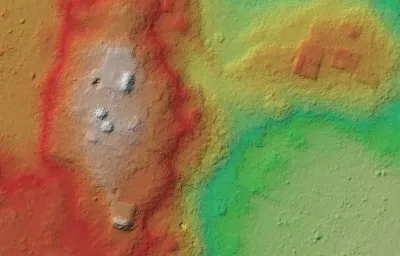 Uxmal and Kabah - An archaeological survey conducted by the National Institute of Anthropology and History (INAH), has identified an 18 km sacbé linking the Maya cities of Uxmal and Kabah in the Puuc region of western Yucatan A sacbé is a raised paved road constructed by the Maya people to connect temples, plazas, and groups of structures within ceremonial centres, or served as major highways between cities. Sacbé comes from a combination of two Yucatec Maya words, “sac” meaning white and “be” or “beh” meaning way, road, or pathway. A recent survey using Light Detection and Ranging (LiDAR) has identified an 18km sacbé linking the Maya cities of Uxmal and Kabah. LiDAR is a method of remote sensing using light in the form of a pulsed laser to measure ranges (variable distances) to the Earth. The study revealed that the sacbé is 5 metres (16 feet) wide and had monumental corbel arches at each end. According to the researchers, the sacbé represents the strong interactions between the people of Uxmal and Kabah around AD 700-950, when both cities were the largest Maya polities in the Puuc region.Uxmal and Kabah also share similar architectural features in the Puuc Maya style, which first emerged at the end of the Late Classic period and experienced its greatest extent during the Terminal Classic period. A common feature at both sites are entwined snakes and, in many cases, two-headed snakes used for masks of the rain god, Chaac.
Uxmal and Kabah - An archaeological survey conducted by the National Institute of Anthropology and History (INAH), has identified an 18 km sacbé linking the Maya cities of Uxmal and Kabah in the Puuc region of western Yucatan A sacbé is a raised paved road constructed by the Maya people to connect temples, plazas, and groups of structures within ceremonial centres, or served as major highways between cities. Sacbé comes from a combination of two Yucatec Maya words, “sac” meaning white and “be” or “beh” meaning way, road, or pathway. A recent survey using Light Detection and Ranging (LiDAR) has identified an 18km sacbé linking the Maya cities of Uxmal and Kabah. LiDAR is a method of remote sensing using light in the form of a pulsed laser to measure ranges (variable distances) to the Earth. The study revealed that the sacbé is 5 metres (16 feet) wide and had monumental corbel arches at each end. According to the researchers, the sacbé represents the strong interactions between the people of Uxmal and Kabah around AD 700-950, when both cities were the largest Maya polities in the Puuc region.Uxmal and Kabah also share similar architectural features in the Puuc Maya style, which first emerged at the end of the Late Classic period and experienced its greatest extent during the Terminal Classic period. A common feature at both sites are entwined snakes and, in many cases, two-headed snakes used for masks of the rain god, Chaac.
Survey finds 18 km Maya sacbé using LiDAR (heritagedaily.com)
MEXIQUE – Ek’ Balam - Archaeologists from the National Institute of Anthropology and History (INAH) have uncovered burials within a chultun storage chamber at the Maya city of Ek’ Balam. Ekʼ Balam was a Maya city in the municipality of Temozón, Yucatán, Mexico. The city was occupied from the Middle Preclassic through the Postclassic, although it ceased to thrive as a major centre following the Late Classic. Recent studies at the East Elevated Plaza of the city Acropolis have led to the discovery of an elite housing enclosure containing stuccoed reliefs that represented captors and captives. Associated with the enclosure are two artificial water tanks known as chultuns. Chultuns are bottle-shaped underground storage chambers used for storing food or water. After a chultun ended its usefulness, some were re-used for discarding refuse or for human burials. One of the Chultuns at Ekʼ Balam was converted into a ritual space and mortuary deposit, filled with a layer of earth, rubble, and stones. Within the deposit is a cylindrical stone, fragments of pottery, and two pieces of obsidian placed as funerary offerings. Removal of the filling layers revealed bones with no anatomical relationship, including a femur and a humerus, as well as part of a jaw and other fragments. A second deposit of skeletal remains was also discovered, which were found placed face down on the surface of the chamber floor. An analysis of the remains suggest that they belonged to an adult female of an advanced age.
Burials found in Maya chultun (heritagedaily.co
FRANCE – Thourotte - Dans le cadre du projet d’aménagement du canal Seine-Nord Europe, une prescription de fouille a été émise sur la commune de Thourotte, en rive droite de l’Oise, à proximité du canal actuel. Sur une superficie de 5 300 m2, les archéologues de l'Inrap ont renseigné des séquences géologiques de berges de l'Oise et mis au jour quelques vestiges néolithiques et une concentration de vestiges lithiques remontant au Mésolithique. Au sud de l’emprise, un petit secteur a livré du mobilier principalement en céramique et quelques structures de type fosse et trou de poteau, organisées en arc de cercle. Le niveau dans lequel s’inscrit les vestiges est recoupé par un chenal. Ces vestiges sont assez fugaces. Leur attribution chronologique s’oriente vers le Néolithique moyen et plus particulièrement vers le Cerny (4600-4200 av. notre ère). Au nord-ouest du site, une nappe de vestiges lithiques d’environ 400 m² a été mise au jour. S’étendant sur 50 m de long et 8 m de large, elle est principalement constituée de silex taillés et de nombreux fragments de calcaire, de grès et de galets de silex brûlés. S’y ajoutent également quelques vestiges osseux épars et de rares outils en os. La quasi-absence de céramique et la nature des pièces en silex semblent orienter leur attribution chronologique vers le Mésolithique. Cet ensemble est constitué de peu d’éléments caractéristiques comme les armatures de flèche. Leur type varie très vite au cours de cette période. Elles permettent bien souvent une datation plus fine, comme le précisera peut-être l'étude de cette série. Cette nappe de mobilier se caractérise néanmoins par une assez forte dispersion verticale des vestiges, de l’ordre de 70 cm en moyenne. Il s’agit d’un phénomène récurent pour les sites préhistoriques du début de l’Holocène qui connaissent généralement une faible sédimentation associée à une forte activité biologique végétale (racines) et animale (terriers) qui remonte certains objets anciens et en enfouit des plus récents. Ainsi, cette nappe pourrait être également constituée de vestiges d’autres périodes, comme cela pourrait être le cas des nombreux fragments de roches brûlés. Ceux-ci se retrouvent en effet parfois accumulés dans des cuvettes au comblement noir, souvent très irrégulières et de taille variables évoquant des chablis brûlés. Un défrichage pourrait donc avoir eu lieu à une période postérieure au Mésolithique, pratique fréquemment observée chez les populations d’agro-pasteurs. L’étude des restes osseux découverts résoudra peut-être cette question grâce à la caractérisation des espèces animales présentes. En effet, la mise en évidence de faunes domestiques comme le bœuf, le mouton ou le cochon, introduites au Néolithique, tranche avec le contexte de faune sauvage du Mésolithique.
Actualité | Des vestiges de fréquentation Mésolithique à T... | Inrap